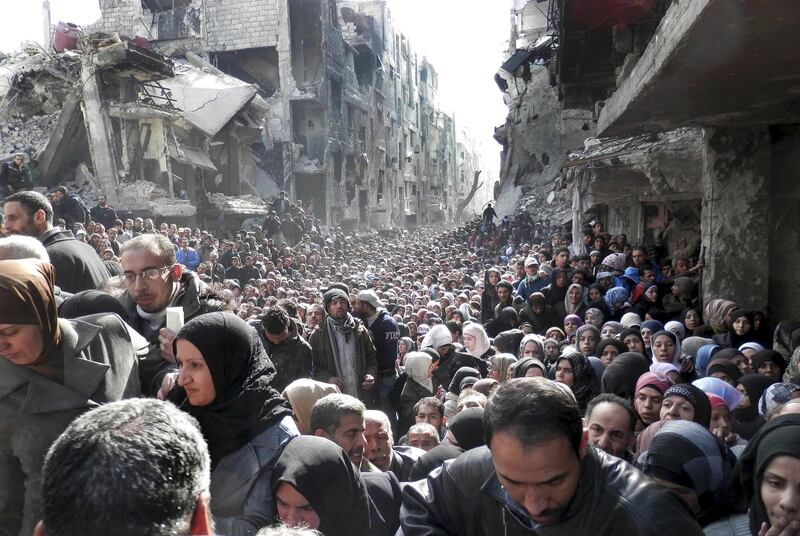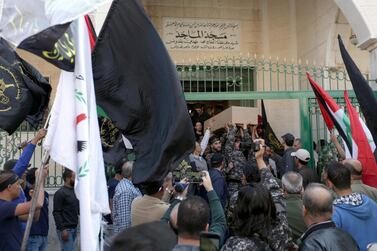Authorities in Damascus say they are preparing reconstruction plans for what was once Syria's largest Palestinian camp, now a war-wasted suburb in the capital's south.
Yarmouk camp, once hailed as the "capital of the Palestinian diaspora", was retaken in a pro-government offensive last spring that secured the last area of the capital outside government control.
Celebrated as a major symbolic victory by the government and its supporters, whole areas of this unique pocket of Syria were completely destroyed as pro-government forces wrested back control from ISIS and other hardline militants.
More than a year later, a Damascus Governorate official quoted in pro-government newspaper Al Watan said that authorities were preparing several bombed-out suburbs for implementation of reconstruction legislation.
Many fear this could lead to the razing of entire areas of cities and the dispossession of millions of Syrian refugees.
Because of the way Yarmouk developed after its establishment in 1957 – it was built on land owned by a government-linked ministry, the General Authority for Palestinian Arab Refugees – its system of ownership is different from many Damascus suburbs being prepared for reconstruction.
Muawiya Mohammed, a Palestinian doctor originally from an area on the peripheries of Yarmouk, now lives in Syria's north-west after boarding an evacuation bus to Idlib province during last year's offensive. While he says his family own their home, for years they were unsure about the legal status of the house.
"Legally we didn't know whether we lived in Yarmouk or [neighbouring] Hajar Al Aswad," he said. "We used to pay our telephone bill in Hajar, and our electricity bill in Yarmouk."
Such stories are typical of the informal settlements that grew across Syria in the decades leading up to the 2011 uprising against Bashar Al Assad.
South Damascus was like many other city-limit areas of Damascus. Rural-urban migrants moved into informal slum areas after the 1980s, creating different systems of ownership – legal and otherwise.
By 2011, Yarmouk had become more Syrian than it was Palestinian. Eventually, it would be dragged into the conflict raging around it.
Damascus suburbs left in ruins
After falling to opposition groups in 2012, the South Damascus suburbs became a knot of competing groups across a few kilometres, where almost every actor in the Syrian conflict had a presence.
Last year, Yarmouk and Hajar Al Aswad were still mostly under the control of ISIS, while Hayat Tahrir Al Sham, the group led by Al Qaeda's former Syria affiliate, held a shell-shattered residential pocket in northern Yarmouk. To the east were Yalda, Babila and Beit Sahem, held by rebels in a partial truce with the Syrian government since 2014.
On April 19 last year, pro-government forces launched a campaign of air strikes and artillery bombardments. Almost anyone still in Yarmouk fled, the bombs edging closer to the basements where they were taking cover. Dozens died.
Many fleeing the onslaught arrived in rebel-held Yalda, already overcrowded after years of war. Some were left sleeping on the streets, as local activists appealed for help finding vacant housing. As the offensive waned, Russian-led reconciliation negotiations secured the evacuation of the three rebel-held neighbourhoods.
Yet since last year's takeover, little has changed in South Damascus. Until now, much of the international focus on reconstruction in Syria has remained fixed on 2018 legislation. The often singular focus on reconstruction has obscured some of the housing crises already under way – with former opposition-held areas of the city far hardest hit.
If they bring back the cafe, who will bring back my friends?”
Immediately after the government takeover last year, hundreds of squatters were evicted.
A representative of a Palestinian relief organisation in Damascus said the original owners were turning to court orders to evict displaced families.
But little more than a kilometre
away from Yalda, Babila and Beit Sahem, a small community has been allowed by government authorities to resettle in an area once called the "Old Camp."
Residents there post photos of swept streets, Palestinian flags and potted-plants hanging from the buildings – signs of a community returned.
And yet, according to humanitarian sources and displaced activists from Yarmouk, these families are there largely by virtue of their family connections to pro-government militias.
The contrast between the two ends of Palestine Street is a sign of the uneven application of reconstruction legislation human rights groups expect to see in cities across Syria.
While residents of the Old Camp post on Facebook about a community being rebuilt, those displaced by war and repressive government rule feel far less sure about the future.
"Since the total destruction of Yarmouk, [the government] has talked and talked about the reconstruction of the camp," Mr Mohammed said, before paraphrasing a poem by Palestinian poet Mahmoud Darwish.
“But if they bring back the road, who will bring back my steps? If they bring back the cafe, who will bring back my friends?”






